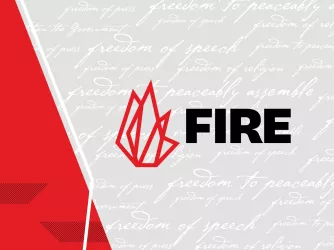Table of Contents
Campus Censorship Zones

FIRE's Harvey A. Silverglate and Josh Gewolb address the scandal of "free speech zones"—censorship zones—in The National Law Journal.
Muzzling Free Speech
By Harvey A. Silverglate and Joshua Gewolb — Special to The National Law Journal
Tuesday, October 1, 2002
OPINION
In the last five years, free speech zones have become the trendiest weapon in campus administrators' war on free expression. More than 20 colleges and universities have established speech-zone systems relegating protests, demonstrations and all other forms of student speech to a handful of places on campus. This past June, the University of Houston (UH) joined a growing number of colleges and universities that have turned their campuses into censorship zones while restricting unfettered expression to a few tiny "free speech zones."
The speech-zones movement presents a major threat to the ideals of free thought and free inquiry to which colleges and universities should be devoted. Free expression, however, means freedom to choose where and when and to whom to speak, not just what to say.
College administrators have used every trick in the book to try to limit student speech: Content-based speech codes were the weapon of choice against "offensive" speech on campuses in the early 1980s, but universities were forced to abandon these codes after courts uniformly struck them down. Since then, administrators have used racial and sexual harassment rules to create de facto speech codes. Though these rules have had a chilling effect on campus discourse, recent court opinions finding it unconstitutional to classify as "harassment" speech that is merely offensive (but not physically threatening), reduce the utility of such rules in suppressing speech.
College speech zones are the rage because they have not yet faced a court test. When they do, however, they will almost certainly be declared unconstitutional on public campuses. The law requires that government infringements on First Amendment rights be narrowly tailored to accomplish a specific, legitimate purpose — which speech zones are not. Public universities can restrict the "time, place and manner of speech" to avoid disturbing, say, sleeping or studying students, but regulations aimed at forcing students to shut up or move to where they won't be heard and seen are constitutionally verboten.
Houston, we have a problem
Ironically, UH established its draconian new speech-zone system almost immediately after a court ruled that its previous policy was unconstitutional. The old policy allowed free expression everywhere on campus, but gave Dean William Munson authority to relegate "potentially disruptive" events to four designated areas. In March, the university allowed a large anti-abortion traveling exhibit on the main campus green. The display proved uneventful. But when a second student group, the Pro-Life Cougars, sought to bring the exhibition back for a second run in June, Munson refused permission, citing its potential disruptiveness.
The Pro-Life Cougars students sued. On June 24, the U.S. District Court for the Southern District of Texas declared Munson's actions and UH's speech policy unconstitutional. The court held that the lack of objective standards in UH's policy invited arbitrary prior restraints, and issued a preliminary injunction ordering UH to let the Cougars erect their display and barring the university from imposing restrictions on speech in the plaza.
The next day, UH's president established the new, more restrictive, zone policy, limiting free speech events on campus to the four zones previously designated for potentially disruptive speech. Students must now register 10 days in advance for even minor protests. Spontaneous demonstrations are relegated to one additional area where amplified sound and signs mounted on sticks are prohibited. Exceptions are only at the dean's discretion.
The new policy appears to seek to avoid the unbridled-discretion problem that was fatal to its predecessor. But the administration apparently has not noted the court's warning that even a contentneutral regulation of speech in a public forum must be narrowly tailored to serve a significant government interest and must leave open ample alternative channels of communication. Simply put, there is no legitimate government interest in moving speech from the heart of campus to more peripheral areas.
Though free speech zones are on the rise at some universities, several schools, including Penn State and the University of Wisconsin, have revoked their freshly minted zone regulations. In May, speech-zone opponents convinced West Virginia University to liberalize a policy that restricted free expression to two classroom-sized areas. The school is now testing a new policy that, though it does not go far enough, lets small groups stage protests anywhere on campus, at any time, without advance permission.
It will take determined advocacy to keep speech zones from invading the rest of America's colleges and universities. But the recent successes at West Virginia University and elsewhere suggest that the censorship zone movement may burn out as precipitously as it has caught fire. There is a growing recognition, especially by students and civil libertarians, that our entire country is a free speech zone, and that our campuses of higher education, of all places, cannot be an exception.
Harvey A. Silverglate, a partner in Boston's Silverglate & Good, is co-author of The Shadow University: The Betrayal of Liberty on America's Campuses and co-founder of The Foundation for Individual Rights in Education (FIRE) (www.thefire.org). Joshua Gewolb is a freelance journalist and special projects coordinator at FIRE.
Recent Articles
Get the latest free speech news and analysis from FIRE.

Introducing the SPFI Sentinel: Free speech stories by — and for — student journalists

Why YouTube caving to Trump is cowardly

FIRE statement on the White House’s Compact for Academic Excellence in Higher Education
